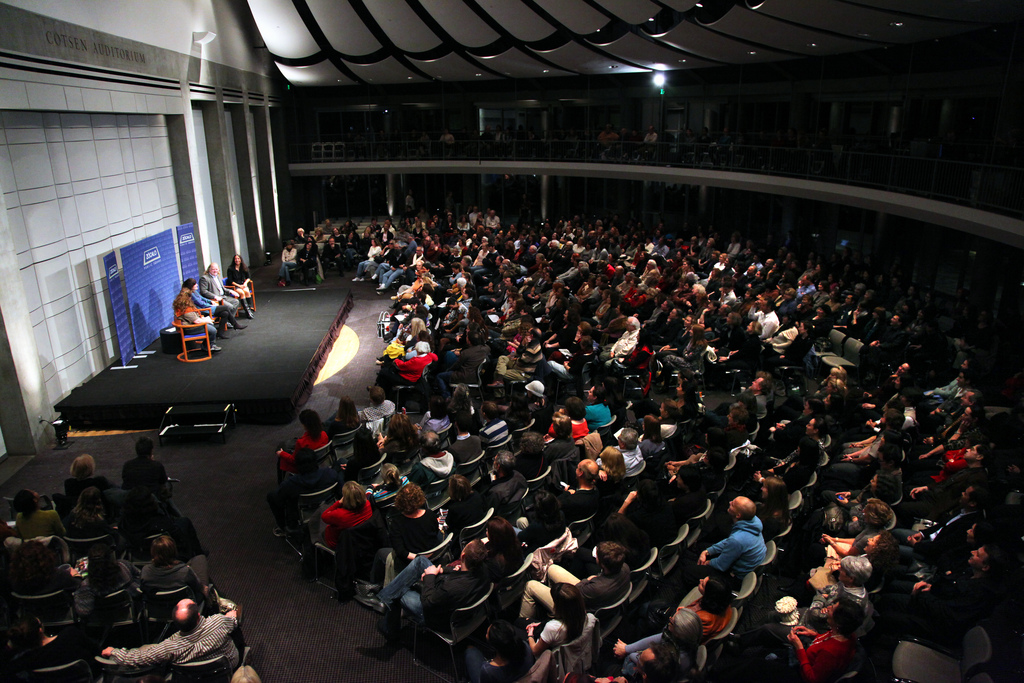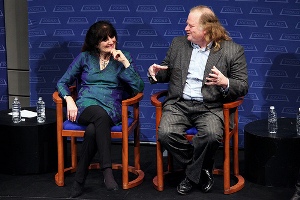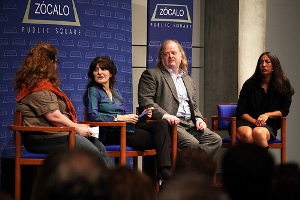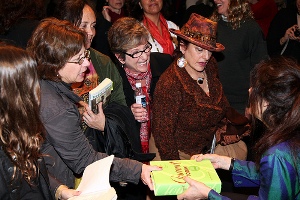
After 70 years, Gourmet magazine ceased publication in October by order of its parent company, Conde Nast. While the decision to cut the magazine that long set the standard for epicurean living – with its heavily-tested recipes, expert food photography, and rich writing – was much discussed, KCRW’s Evan Kleiman joined Zócalo to have a different sort of conversation, as she joined former Gourmet editors Ruth Reichl and Laurie Ochoa and former Gourmet writer Jonathan Gold.
“This is a wonderful, homey reunion,” she said, “and an opportunity to have a conversation about things you maybe didn’t hear discussed.”
Kleiman, Reichl, Ochoa and Gold recalled the magazine they came to when they arrived in the 1990s, the ways they transformed it, and the way it transformed the way Americans see food.
Judge by the cover
When Gourmet recruited Reichl to become editor, she explained, “I said I would do it if Laurie and Jonathan would come with me.” Reichl, Gold and Ochoa had worked together on the Food section of the Los Angeles Times, revamping it within days of taking charge.
The three would try the same transformation when they came to Gourmet, at a time that Reichl called a particularly vibrant one for food. Gourmet had covered American food for decades but, she said, it had become “old-fashioned.” “I thought of it as a publication for about a thousand very wealthy people, who used it to give to their travel agents and say these are the trips that I want to take,” she said. “There was no fun. There was no sense of this food revolution.”
 Reichl tried to infuse it with the politics, sociology, and environmental science of food just coming to broad attention for Americans. Ochoa recalled that the first cover under their tenure sought to introduce the feeling of a farmer’s market – a woman holding berries out to the reader in her open hands. The inspiration, Reichl said, came from a favorite photograph of hers, of a French peasant woman holding a handful of chanterelles, suggesting “this is for you, I want to feed you.” Reichl wasn’t entirely pleased with the final image – the “pretty young model” and the berries didn’t get the same “sense of the wonder of food.” But Ochoa noted that the first cover balanced the storied past of Gourmet – by keeping the logo, for example – while instituting a new image. And the covers, Kleiman said, are crucial because “the cover brought you in. To me, as a kid, it was the first inkling that there were worlds about which I knew nothing.”
Reichl tried to infuse it with the politics, sociology, and environmental science of food just coming to broad attention for Americans. Ochoa recalled that the first cover under their tenure sought to introduce the feeling of a farmer’s market – a woman holding berries out to the reader in her open hands. The inspiration, Reichl said, came from a favorite photograph of hers, of a French peasant woman holding a handful of chanterelles, suggesting “this is for you, I want to feed you.” Reichl wasn’t entirely pleased with the final image – the “pretty young model” and the berries didn’t get the same “sense of the wonder of food.” But Ochoa noted that the first cover balanced the storied past of Gourmet – by keeping the logo, for example – while instituting a new image. And the covers, Kleiman said, are crucial because “the cover brought you in. To me, as a kid, it was the first inkling that there were worlds about which I knew nothing.”
Contents and caterpillars
The inside of the magazine – the offices and the pages – underwent changes as well. The magazine had long been edited “from the top down,” Reichl explained, with an editor selecting and assigning stories. She helped start weekly meetings in which staff would present ideas; old staff suggested issues about produce and farmers, as well as more in-depth travel. Conde Nast “basically said do what you want,” she said. Cooks, too, were more involved – discussing and debating recipes, each working in their own small kitchen (dreading, Gold pointed out, taste-tests by Ochoa and Reichl). “They never assumed that they knew everything already,” Ochoa said. Gold recalled going into a restaurant with a group of chefs for annual trips, like “a group of locusts that were devouring not just the food but stripping all the information to be gleaned from the cuisine, the waiters, the chefs.” Test cooks were allowed, dating from Gourmet’s flush early days, one annual trip per year to anywhere in the world, for cooking classes. “That is gone forever in America, that kind of luxury,” Reichl said.
 Reichl and her team also began to be more flexible timing the magazine, rather than deciding what would be covered long in advance, and recruited strong literary writers rather than old standbys. “We had to introduce creative chaos in the system,” she said, adding later that “You let people follow their obsessions, and that’s when you get the best pieces.” (To which Gold replied, “Food is a subject that has, and always will, attract the obsessive.”)
Reichl and her team also began to be more flexible timing the magazine, rather than deciding what would be covered long in advance, and recruited strong literary writers rather than old standbys. “We had to introduce creative chaos in the system,” she said, adding later that “You let people follow their obsessions, and that’s when you get the best pieces.” (To which Gold replied, “Food is a subject that has, and always will, attract the obsessive.”)
For Gold, the move from newspaper to magazine gave him many more words to work with. “It sounds pretentious,” he said, but he “wanted to try at least to do for restaurant writing what Pauline Kael had done for movie writing – to take something that had been pretty purely a consumer column, though sometimes a very well done one, and be able to explode it.” Gourmet let him do it, Gold said, by giving him more space and letting him visit restaurants up to 10 times before reviewing.
Those multiple visits didn’t always go well for the restaurant, as Gold revealed. On his last visit to a very expensive Alain Ducasse restaurant, he found, in his “beautiful little green salad, a tiny little green inchworm,” he said. “You’ve seen The Very Hungry Caterpillar?” When the restaurant staff saw him playing with the worm, Gold said, “I told him it was OK, I’m from California. We understand these things. It means the lettuce was organic.”
Closing
The initial response to changes to Gourmet weren’t all thankful – thousands wrote in to say, Reichl admitted, “You have ruined the best magazine in America.” Reichl hired staff to handwrite notes in response, to explain their decisions to readers. Ochoa noted in Q&A that Gourmet was the rare magazine that didn’t condescend to its readers.
 When Gourmet closed, its circulation was just under a million readers, a record, and its impact growing as Americans began to think about ethical eating and the politics of food. The December issue – which Reichl said had five covers, three elaborate full meals, and other special features – was only two weeks away. The test kitchens are “lonely, unused, but still there,” though their fate is unknown, she said. The website will remain up, without updates, and the recipes remain on Epicurious.com. Its 3,500-strong library of cookbooks will be donated to NYU. And there may be plans to put the magazine onto discs. “Magazines are not dead,” Reichl said. “We’re not going to have print magazines in the way we have had them, but it doesn’t mean we’re not going to have magazines.” Reichl admitted too that magazines may have to get smaller, recalling one small publication telling her, “Here’s why we’re the future and you’re toast: there’s six of us and there’s sixty of you.”
When Gourmet closed, its circulation was just under a million readers, a record, and its impact growing as Americans began to think about ethical eating and the politics of food. The December issue – which Reichl said had five covers, three elaborate full meals, and other special features – was only two weeks away. The test kitchens are “lonely, unused, but still there,” though their fate is unknown, she said. The website will remain up, without updates, and the recipes remain on Epicurious.com. Its 3,500-strong library of cookbooks will be donated to NYU. And there may be plans to put the magazine onto discs. “Magazines are not dead,” Reichl said. “We’re not going to have print magazines in the way we have had them, but it doesn’t mean we’re not going to have magazines.” Reichl admitted too that magazines may have to get smaller, recalling one small publication telling her, “Here’s why we’re the future and you’re toast: there’s six of us and there’s sixty of you.”
But the magazine’s legacy remains, Reichl said, having been “the voice of American food for a very long time…at the very time that American food was coming of age.”
Watch the video here.
See more photos here.
Read In The Green Room interviews with the guests: Evan Kleiman, Ruth Reichl, Jonathan Gold and Laurie Ochoa.
*Photos by Aaron Salcido.




Send A Letter To the Editors